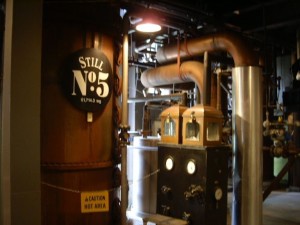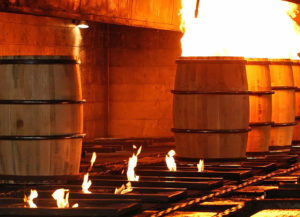Understanding Types Of American Whiskey
By Richard Thomas

(Credit: Brown-Forman)
Part of the Bourbon Boom is the way in which the rise of Kentucky’s Native Spirit has tugged the other major categories of American whiskey on its coattails. Once upon a time, rye whiskey was a sleepy thing, known to most because of Don McLean’s song “American Pie.” Wheat whiskey and American malt whiskey had all but ceased to exist as their own categories. Now rye is resurgent, pundits speak of American malt whiskey as “the next big thing,” and even wheat whiskey has grown into a diverse-if-still-small niche.
Bourbon, Malt, Rye And Wheat
The most interesting thing about these major categories of American whiskey is their commonalities. Under Federal law, all four are to be distilled to not more than 160 proof and entered into new oak barrels at not more than 125 proof. The rules regarding what they can be aged in and for how long are the same. The main statutory variable is the mash bill, with each type named for the particular grain that is to comprise 51% or more of the whole. Thus bourbon is 51%-plus corn, rye 51%-plus rye and so on.
Tennessee Whiskey
Whereas most categories of American whiskey are defined by Federal law, Tennessee whiskey is defined by state law (as befits a whiskey strictly identified by its native state). The 2013 Tennessee Whiskey Law copied the Federal statue regarding bourbon, except where the state added certain stipulations. The most important of these was the requirement to use the Lincoln County Process, or filtration through sugar maple charcoal prior to aging.

Corn
Another whiskey type, governed by slightly different rules, that has seen a revival is corn whiskey. White whiskey is a little passe nowadays, mixologists excepted, but legal moonshine is still going strong, and a lot of it is corn whiskey. Since bourbon is already occupying the 51%-plus corn spot, corn whiskeys are required to be 80% or more corn. Aging in oak is optional, but it aged the barrel must either be used oak or uncharred new oak.
Although it is not a requirement, Tennessee whiskey is traditionally in the “high corn” style, with Jack Daniel’s using 80% corn and George Dickel using 84% corn. Ergo both would qualify as corn whiskeys on a mash bill basis, even with the Lincoln County Process applied. The difference is that Tennessee whiskeys and high corn bourbons are aged in charred new oak and corn whiskey is not. Comparing the Tennessee whiskeys to aged corn whiskeys like Mellow Corn and (presumably) Barrell Whiskey Batch 003 grant a point of comparison for what the difference between aging in new and used oak really is by reducing the influence of the mash bill.
Light And Spirit
Two types of American whiskey are lesser known, and, to the degree that they are known to consumers, are often scoffed at: light whiskey and spirit whiskey. The irony of these two, light whiskeys in particular, is that many of today’s trendy and popular sourced whiskeys are made using them. Most of the croakers are revealing their ignorance by dismissing light whiskey in one post, while praising a light whiskey-derived product in another.

(Credit: Brown-Forman)
Light whiskey is different from all other types of American whiskey described heretofore in that it is distilled to a higher proof, hence its “lighter” character. Whereas until now the roof at the still was 160 proof (80% ABV), that is the floor for light whiskey. Light whiskey must also be aged in used or uncharred new oak barrels, similar to corn whiskey.
This type of whiskey was introduced in the 1960s, designed to compete with vodka and gin in the days before the world whisk(e)y crash of the 1970s. Today some light whiskey expressions have begun appearing, but light whiskey more often sees use as a constituent in blended whiskey products going under several different names. Under Federal guidelines, so long as the resulting blend is 80% or more of something else (on a proof gallon basis), the end product isn’t a light whiskey.
Compared to light whiskey, spirit whiskey deserves much of the scorn heaped on it, in those infrequent instances where it is mentioned. This is a blend of neutral spirits and whiskey, and the whiskey component is merely required to not be more than 5%. Basically, spirit whiskey can very easily be watered down Everclear with a little cheap whiskey added for flavoring.





Great article, as usual, at least until the end. I don’t believe spirit whiskey should be compared to light whisky. Light whisky is distilled to be exactly that product, while spirit whisky is really a subset of blended whisky in the federal standards, so might better be compared to blended whisky.
Spirit whisky is defined as : “… a mixture of neutral spirits and not less than 5 percent on a proof gallon basis of whisky, or straight whisky, or straight whisky and whisky, if the straight whisky component is less than 20 percent on a proof gallon basis. ” As such, it can make up between 5 and up to 20 percent of the blend.
Blended whisky must contain 20 percent or more whisky. I’m deferring to the standards for my spelling of “whisky” here.
Thanks again for the frequent and pertinent updates to your blog. It remanis one of the very best on the subject.
Yes, I wouldn’t lump them together in terms of qualitative issues, and say as much. In terms of familiarity and availability as stand alone products, however, the two are in the same league.